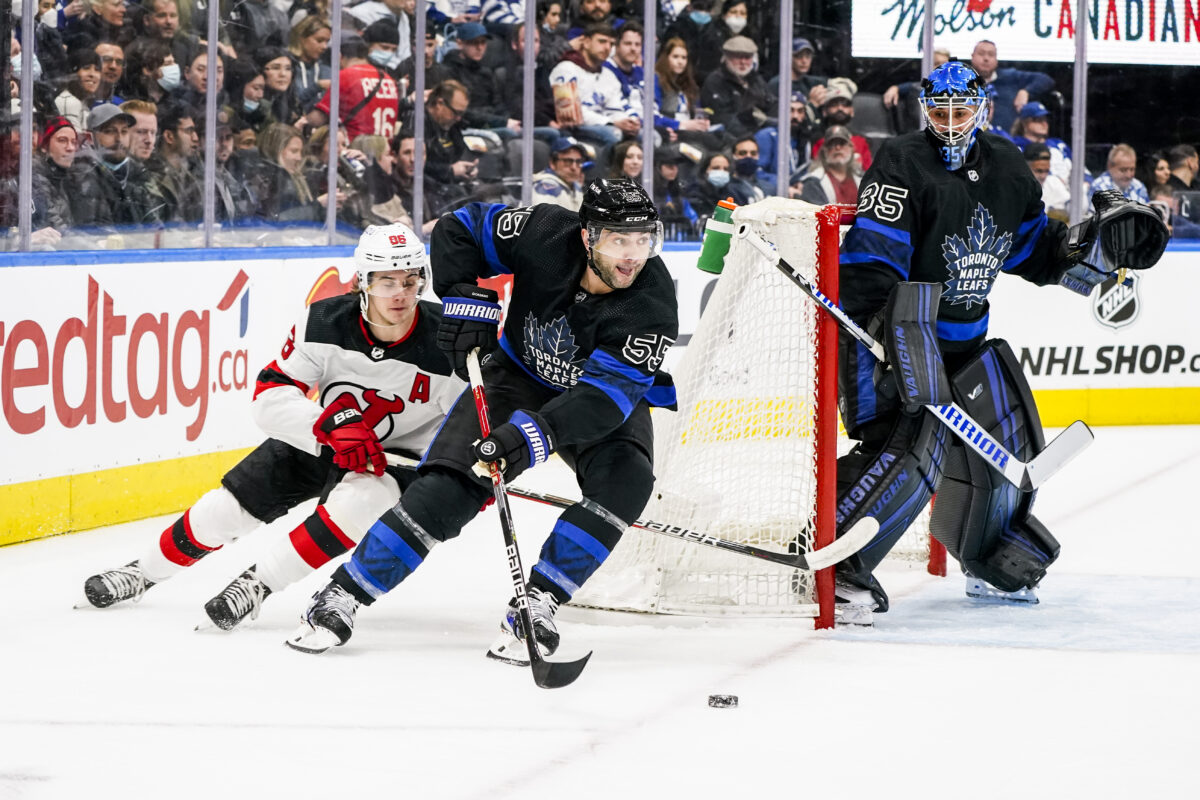In previous posts, we have done player reviews of all the Toronto Maple Leafs’ forwards who will be returning from last season’s roster. We have also now reviewed three members of the Maple Leafs’ defense – Morgan Rielly, TJ Brodie, and Jake Muzzin. In today’s post, we’ll do player reviews of Timothy Liljegren and Rasmus Sandin.
As a reminder, if you missed the first 13 player reviews, we’re basing these reviews on the extensive film study and note-taking of long-time Maple Leafs’ fan Stan Smith. When he reviews each game after it’s played, he notes what each player does with the puck, without the puck, where they are, and what they’re doing while not directly involved in the play, etc.
Maple Leafs Player #14: Timothy Liljegren
Timothy Liljegren came into the Maple Leafs’ picture with a lot of hoopla after the Maple Leafs drafted him 17th in the 2017 NHL Entry Draft. Liljegren had been ranked as high as third in that draft but dropped down the order due to his lack of playing time in his draft year after a bout of mononucleosis. The Maple Leafs getting Liljegren that low in the first round was seen as quite a coup.
Despite His Potential, Liljegren Struggled
Despite the positive commotion Liljegren’s signing drew, he struggled with the Marlies in his first two seasons. There was speculation at the time that he might not be NHL material, and he became the subject of numerous trade rumors.

Stan was able to watch many Marlies games during Liljegren’s tenure there. One of Liljegren’s assets was supposed to be his speed, yet he did not really show that speed. He also made questionable decisions with the puck. Had the Maple Leafs made a mistake in thinking so highly of him or was it a case of Liljegren struggling with the smaller ice surface?
Finally, Liljegren Found His Game
In 2019-20 Liljegren seemed to find his game as the season progressed. He was stronger on his skates and appeared more confident both with and without the puck. He finished that season with 30 points in 40 games for the Marlies.
In the shortened 2020-21 season, Liljegren’s production dropped to 11 points in 21 games but Liljegren took his defensive game to the next level. Liljegren earned a spot with the Maple Leafs out of the 2021 training camp and really came into his own in the latter half of the season. He got to play with all three of Morgan Rielly, Jake Muzzin, and Mark Giordano which really seemed to help his development.

Liljegren has improved his game by keeping it simple. He makes the short sure passes most of the time and has good awareness of where other players are on the ice. While he’s not a speedster on skates, he can hold his own. Like many Maple Leafs’ players, Liljegren is not overly physical; however, again he can hold his own when the going gets rough.
Liljegren Needs to Keep Working on His Defensive Game
Liljegren still needs to work on his defensive game. That’s to be expected from a 23-year-old defenseman with only 76 games of NHL experience.
Related: Top-5 Ukrainians in NHL History
While Justin Holl ended up playing in the playoffs last season over Liljegren, we expect Liljegren to move ahead of Holl on the right side depth chart.
Maple Leafs Player #15: Rasmus Sandin
Unlike Liljegren, Sandin burst out of blocks the second he stepped on the ice for the Maple Leafs. At the time Sandin was drafted, Liljegren was seen to be the Maple Leafs’ top prospect. It took Sandin less than a month to bypass Liljegren to take over that #1 spot.
Sandin Makes His NHL Debut Before Liljegren
Despite being drafted a year later than Liljegren, Sandin made his NHL debut four months ahead of Liljegren. He played well enough in six games to start the 2019-20 season that the Maple Leafs burned a year of his ELC and brought him back to play 22 more games to cover injury problems later that same season.

After having a great start to his career, two knee injuries, a bout of Covid-19, and a lack of playing time due to the pandemic seemed to stall Sandin’s development. When he was finally healthy, he found himself on the outside looking in after the Maple Leafs acquired Mark Giordano at the trade deadline last season.
With Giordano signing for two more years, Sandin still sits fourth on the Maple Leafs’ left-side defensemen depth chart. That position might be contributing to his present contract standoff.
Sandin’s Skills on the Ice
To this point in his career, we see Sandin as a playmaker who’s good with the puck. He sees the ice well and has the ability to either skate himself out of trouble or pass the puck instead. He sees the ice well and has a good awareness of where other players are.
Related: Maple Leafs News & Rumors: Liljegren, Eeyore & Next Year’s Stanley Cup
Some fans believe Sandin is a slow skater. Our observations disagree. Whatever Sandin might lack in pure straight-line speed he makes up for in maneuverability. When he has the puck, Sandin rarely skates in a straight line. He moves more East to West and has excellent lateral movement. Sandin is also an effortless-looking skater, which might lead to some criticism.
Sandin Still Makes Mistakes with the Puck
At times, Sandin makes mistakes with the puck. It’s almost as if he’s trying to be too cute with it. Those mistakes result in occasional turnovers. As an offensive-first-minded player, he also has a tendency to get caught out of position.
With only playing 66 games in the AHL, Sandin has been forced to learn the defensive part of the game in the NHL. He’s also 22 years old with only 93 games of NHL experience.

We personally think Sandin has a ton of upside. The last drafted Maple Leafs’ defenseman we’ve seen with this much talent was Morgan Rielly.
Where Do Liljegren vs Sandin Rank Against Each Other?
In an upcoming post, we’ll look at Liljegren vs Sandin and compare where they might rank against each other on the Maple Leafs’ pecking order. However, as a trailer, it’s tough to compare the two players because they’re quite different.
More to come.
[Note: I want to thank long-time Maple Leafs’ fan Stan Smith for collaborating with me on this post. Stan’s Facebook profile can be found here.]
